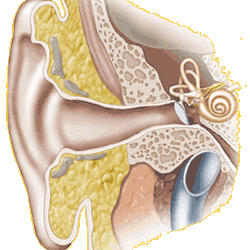Chapter 9 Overview
Hearing: Physiology and Psychoacoustics

This chapter covers the basic physics, physiology, and psychophysics of audition (hearing). Hearing begins when an object (e.g., a tuning fork, a stereo speaker, a wasp’s wings, or a person’s vocal cords) vibrates, causing a series of pressure fluctuations to move through the air (if we are on dry land) or water (if we find ourselves in the ocean or a swimming pool). Once they reach your ear, these pressure fluctuations start a convoluted Rube Goldberg machine-like series of events that eventually lead you to hear something. (See an example of a Rube Goldberg machine—not an ear—here.)
As demonstrated in the activity on What We Hear, we are remarkably good at determining exactly what object made the air pressure changes we hear. You will learn about the intricate structures of the ear diagrammed at right by exploring the interactive activity on the Structure of the Auditory System. The final activity for this chapter walks you through an interpretation of the Equal-Loudness Curves presented in the text.
Once you’ve read the chapter in the textbook and done the activities here, use the study aids (Study Questions, Flashcards, and Chapter Summary) to review.